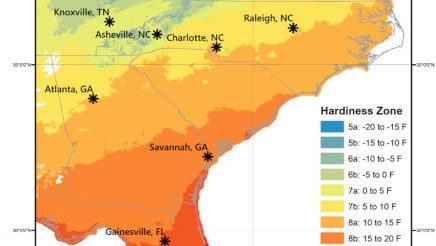New SE CASC Publication Provides Insight into the Impact of Urbanization, Latitudinal Warming, and Insects on Urban Tree Health

A recent article co-authored by a team of SE CASC researchers – Michael Just (2013-14 Global Change Fellow), Larry Long (2016-17 Global Change Fellow), Adam Dale (2014-15 Global Change Fellow), and Steve Frank, NCSU Researcher and Co-Investigator – Urbanization Drives Unique Latitudinal Patterns of Insect Herbivory and Tree Condition -investigates the interaction of urbanization, latitudinal warming, and scale insect abundance on urban tree health. The research was supported by SE CASC project, Consequences of Urbanization and Climate Change on Human and Ecosystem Health. The following summary was published as a post on the ECOIPM website by Frank Lab postdoc Michael Just. The original post can be viewed here, and a NC State News post here.
Not all ecological patterns hold true in cities
Urban trees are an important part of our infrastructure, that provide benefits like air and water filtration, shade, and, generally, contribute to salubrious environments for humans. In the Frank Lab, we study some of the challenges that trees encounter in cities (e.g., this and this). These studies have revealed that one of the most important urban challenges is the amount of impervious surface (e.g., concrete, pavement) surrounding a tree. As impervious surface increases, so does temperature, resulting in greater insect pest abundances and worse tree health (read more here or here).
Outside of cities, in natural environments, it has long been noted by researchers that herbivore abundance and feeding increases near the equator where the climate is warmer. This phenomenon is similar to our previous observations in cities, where we found that the warmer parts of a city (i.e., those parts with more impervious surface) had greater herbivore activity. But does this mean that cities closer to the equator would have even more insect pests and trees in poorer health? That is, does this latitudinal-herbivory pattern observed in natural areas apply to cities?
We predicted that trees in the more southern cities would be in poorer condition with more herbivores, because of a warming double-whammy, that is, the warming related to city life (read more here) and also being closer to the equator. To evaluate our prediction, we conducted a study in eight cities spanning from Newark, DE in the north to Gainesville, FL in the south. The area encompassed by these cities is the southern half of the geographic range of red maple. In each city, we visited red maples and recorded their condition (Good, Poor), the amount of impervious surface surrounding each tree, and the abundance of scale insect herbivores. We used these data to analyze the patterns of tree health, herbivore abundance, and temperature (latitude).
Our predictions based on established ecological theory were not supported. Scale insect abundance did not increase in southern cities nor were red maples in even worse condition. What we found was that impervious surface (a surrogate for urbanization) was the most important predictor of both tree condition and herbivore abundance. We also observed a peak in herbivore abundance in the mid-latitudes of our study. These findings suggest that not all ecological theories developed in natural ecosystems are applicable in contrived ecosystems like cities. Thus, it is important to test these theories in cities before we use them to make management and conservation plans for urban plants and animals.
Read the full paper:
Just, M.G., Long, L.C., Dale, A.G., and Frank, S.D. (forthcoming), Urbanization drives unique latitudinal patterns of insect herbivory and tree condition. Oikos. https://doi.org/10.1111/oik.05874
- Categories: